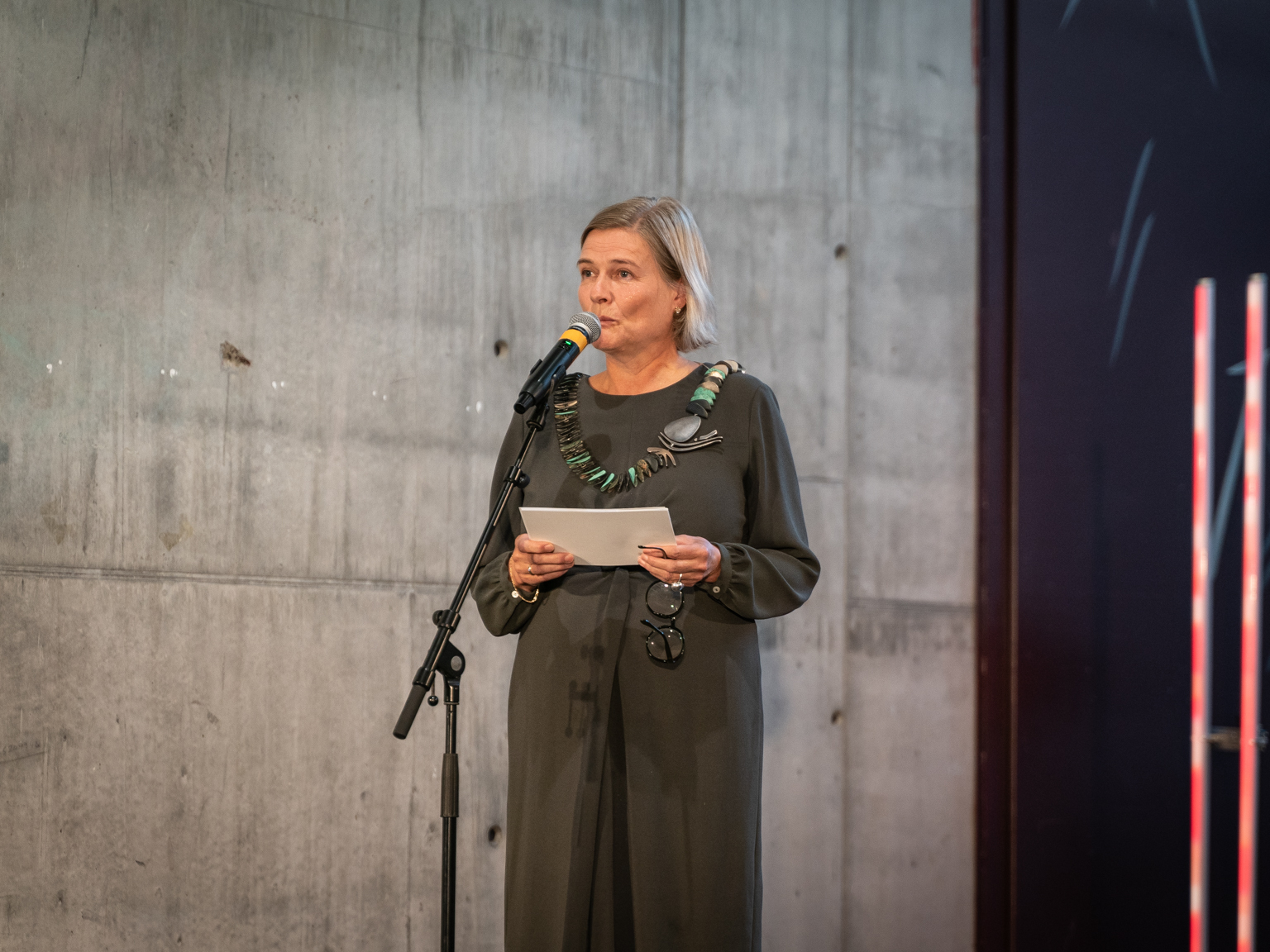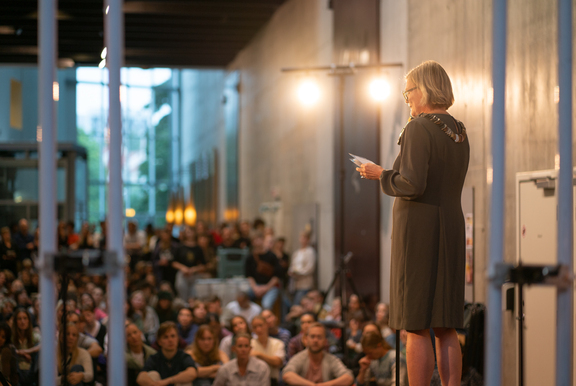
Start of studies 2024: speech from the rector
Marianne Skjulhaug's speech to the KHiO students.
Dear new students,
It is my great pleasure to welcome you here to your studies at the Oslo National Academy of the Arts. I congratulate each and every one of you on securing a study place, and I extend my warmest welcome. My name is Marianne Skjulhaug, and I am the rector here.
Those of us who work here at the Academy know how much it has cost every one of you to pass the rigorous entrance exams and critical evaluations that all our applicants must face. Few programmes in Norway have a smaller needle you have to thread yourself through. But now the admissions process is over and done with – you can finally lower your shoulders, get to know one another, and find your flow and the sense of joy that comes from creating and developing your own artistic voices.
The entire academic, technical, and administrative staff here is ready to make your studies as best as possible for you. Our expectation is that together we will create good learning environments that promote diversity, the community, and everyone here.
I would also like to take the opportunity to welcome back all of our staff and our old students for a new semester and a new academic year.
The Oslo National Academy of the Arts, or KHiO, is the largest academic institution for artists and designers in Norway. We are a specialised university with great ambitions. The institution consists of six departments: the Academy of Dance, the Academy of Fine Art, the Academy of Opera, the Academy of Theatre, the Art and Craft department and the Design department. The Academy offers a range of Bachelor’s and Master’s programmes. We also offers a PhD in artistic research and are a leading institution in both artistic and academic research within the arts, both nationally and internationally.
In other words, we are a wide-ranging artistic community that strives to find our place as one of the internationally leading educational institutions within the disciplines we teach here. The Academy is characterised by how our teaching, artistic research, academic research and public outreach activities are all rooted in the artistic and creative practices of our staff and students, what we at the Academy call the “artistic core”. The artistic core means that both the educational and research activities here take place based on artistic methods and creativity – not externally, but through art.
In order to achieve this goal, it is essential that our students, teachers and technical and administrative staff all work closely together and also interact with the professional field of art. We also depend completely on the facilities we have here – our studios, showrooms, stages and workshops. Dance, opera, theatre, design, arts and crafts, and the visual arts – in all their various forms – are neither created nor explored in a reading room. For someone to be able to develop their own distinctive voice, whether as an artist or as an art educator, they must be given the chance to try things out, meet an audience, make mistakes, start over again, challenge themselves, provoke themselves (and others!) and ultimately perfect their craft. Art requires space.
Every year, around 3,500 individuals apply to the Academy with a desire to become artists. This is a clear indication that art is essential to many people.
Nearly a hundred years ago, the Austrian philosopher Hermann Broch published his essay “The Worldview of the Novel”, where he spoke of how art is “the impatience of recognition” and will always engage in a dialogue with the world, and that its creative form allows it to “anticipate” the future, or more precisely the “future cosmogony”. It’s not difficult to talk about why art is essential – that can be done in an infinite number of ways. I refer specifically to Broch, however, because the world today is completely reliant on change and a new direction in order for there to be a future, and because I claim that art is one of the most important driving forces to achieve this.
Nevertheless, art’s value – its usefulness – is constantly being questioned. And right now, in these times of crisis, it seems as though politicians and the powers-that-be often fail to understand how art can help develop society, and how full of potential it is.
Furthermore, the conventional wisdom seems to be that when we, as a society, are trying to bring about a green shift in our policies, regulate artificial intelligence, end cruel, archaic types of war and stop the loss of biodiversity, artists should not be among the people who are consulted first. But why is that so?
The ongoing loss of biodiversity has serious consequences for our way of life. According to the World Economic Forum, half of the world’s value creation depends on nature, whether in whole or in part. It goes without saying that major changes are called for, and this will require great creativity and imagination. My claim is that art constantly offers vital, new approaches and understandings. Nevertheless, and incomprehensibly enough, five critically important governmental papers that have discussed the future development of Norwegian society fail to mention art at all.
More than ever, there is a need not only to understand natural and social connections, but also to nurture a joyful spirt and sense of togetherness, not only among people, but also between people and nature, between people on the one hand and minerals, animals and plants on the other. The search for sustainable ways of living must be constantly intensified.
Although there are no obvious solutions here, merely following the conventional wisdom may well lead people astray, including politicians and all kinds of decision makers. Therefore, my challenge to you is this: give us new performances and narratives, and take all the space you need, and do so unabashedly, because our precarious age needs it. I believe that both the ability to ask challenging, new questions and the ability to move people – the very abilities that characterise art – can help bring about the necessary social changes.
This is why I’m so excited that you are all here, that you came to the Academy, that you’ve chosen one of the most demanding paths within higher education – that you want to become artists.
Professor Merete Mørk Lingjærde says it quite simply: it’s all about blood, sweat and tears.
Don’t worry if things sometimes get rough. Use your creativity and imagination to challenge both yourself and others, to create things no one has seen or experienced yet – dare to use your experiences to shape the art that our future needs.
I really look forward to following you all in the years to come.
Keep your spirits up, and good luck!
